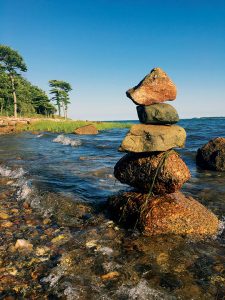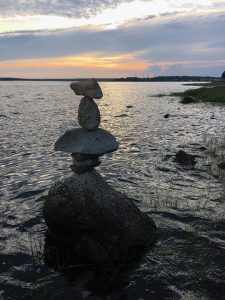Once in a while you’re out in nature approaching a bend in a hiking path, reaching the top of a mountain, or, in this case, meandering along the beach, and you come across something that draws your eye in. Someone has taken stones and carefully stacked them one on top of each other, perfectly balanced and oftentimes appearing to defy gravity itself.
The rocks, although perfectly natural and at home in the setting, are far from natural in their formation.
Just when you thought you were the only one out there, with the rest of the world forgotten about for the time being, feeling alone and at one with your aloneness, someone has left behind a sign of having passed that way before, of having existed momentarily in the place at which you find yourself, and is in a way saying to you, “Hi. I was here.”
For centuries, humans have been stacking rocks all over the world as ways to mark a significant place, a gravesite, the location of a battle in history, or as trail blazes to guide others along as they hike. This human-made stacking of rocks is commonly known as a cairn, from the Scottish Gaelic word càrn.
I come across a few of these now and again as one who spends a lot of time exploring the outdoors and traveling about to hike new hills and discover forest trails I’ve never been down before. Every now and then, they start cropping up along a stretch of beach at the Nasketucket Bay State Reservation as they have been over the past few days. Some have gotten a bit creative, too, incorporating driftwood and seashells along with the usual rock tower formations.
One late afternoon last week, I was walking along quietly deep in thought when from afar I spotted a group of them and it yanked me out from my flow of inner consciousness back to the beach where I stood.
I walked up and pondered the cairns, appreciating the transience of this temporary art installation and wondered about the people and the reasons why they would build them.
Some people wish upon the rocks as they balance them up, wishes that are likely the same or similar to the wishes we all secretly have. Wishes that may or may not come true before or after the sea swallows them up and the rocks tumble down.
The cairns could be a way of connecting with others on a spiritual level, leaving behind a sculpture of peace and tranquility, which seems to me the silent language of the cairn and how I usually feel when I look at it.
Not all people feel that way when coming across a cairn, however. Actually, there are a lot of people, including conservationists, telling people to please just stop it already with the cairn building. The old hiker’s adage of “leave no trace” echoes out from cairn to cairn, and some areas in the world, notably Iceland, have essentially been invaded by cairns created and left by tourists oblivious to the effects of leaving behind stacks of stones everywhere. In some areas, cairns are cropping up uncontrollably and are even threatening the very ecosystem and habitat of local wildlife.
At the Nasketucket Bay State Reservation beach, though, they seem right at home. I imagine some young people stopping to stack rocks together for a while, testing their balancing abilities and starting over again with the occasional mishap when that final rock on top doesn’t quite make it so they exchange it for another that might do the trick.
I think about my life and the symbolic cairns that mark the different paths I’ve taken, and I think about the metaphorical cairns I may have built along the way that perhaps have guided others who came after me. And I ponder the mystery of it all and the messages left by the people who balanced the rocks on the mountains, the deep forest trails, and the beaches for me to see that seem to say, “I was here before you, I passed this way too, and you are not alone.”
By Jean Perry

